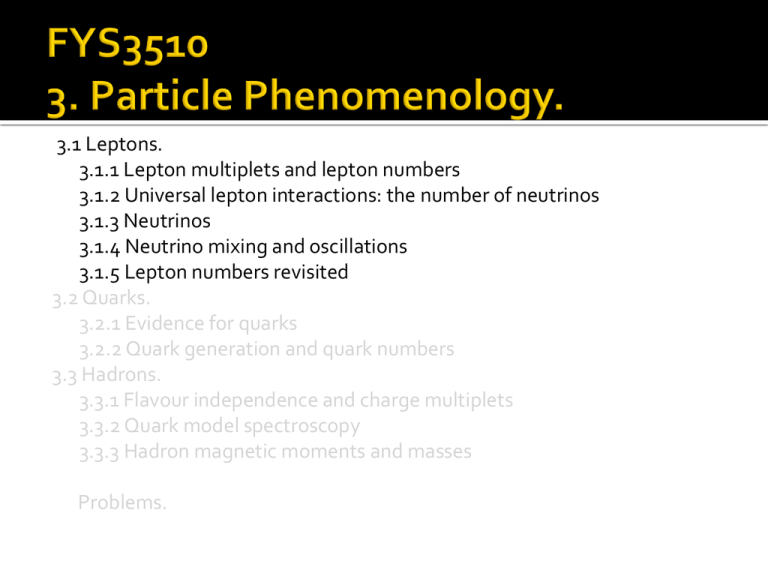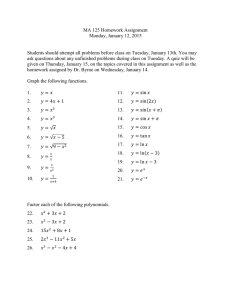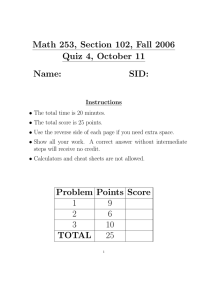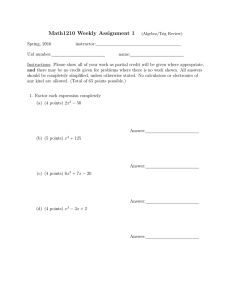Document 11541185
advertisement

3.1 Leptons. 3.1.1 Lepton multiplets and lepton numbers 3.1.2 Universal lepton interactions: the number of neutrinos 3.1.3 Neutrinos 3.1.4 Neutrino mixing and oscillations 3.1.5 Lepton numbers revisited 3.2 Quarks. 3.2.1 Evidence for quarks 3.2.2 Quark generation and quark numbers 3.3 Hadrons. 3.3.1 Flavour independence and charge multiplets 3.3.2 Quark model spectroscopy 3.3.3 Hadron magnetic moments and masses Problems. ¡
6 lepton flavours in 3 generations and corresponding anti-­‐leptons ⎛ νe ⎞
⎜ − ⎟ ,
⎜ e ⎟
⎝ ⎠
⎛ ν µ ⎞
⎜ ⎟ ,
⎜ µ− ⎟
⎝ ⎠
⎛ ντ ⎞
⎜ − ⎟
⎜ τ ⎟
⎝ ⎠
⎛ e+ ⎞
⎜ ⎟ ,
⎜ ν ⎟
⎝ e ⎠
⎛ µ+ ⎞
⎜ ⎟ ,
⎜ ν ⎟
⎝ µ ⎠
⎛ τ + ⎞
⎜ ⎟
⎜ ν ⎟
⎝ τ ⎠
§ Charged leptons interact EM and weakly, neutrinos only weakly
▪ Neutrinos have very small masses and are very difficult to detect ▪ electron: stable
µ − →e −ν e ν µ ; µ + →e +ν eν µ
τ µ = (2.197019 ± 0.000021) × 10 −6 s
▪ µ decays to e (100%) τ − →e −ν eντ ; τ + → µ +ν µντ ;... ττ = (2.906 ± 0.011) × 10 −13 s
▪ τ decays to e, µ (35%) and to hadrons (65% à ντ +π ’s) Le ≡ N (e − ) − N (e + ) + N (νe ) − N (νe )
€
¡ Lepton numbers: Le, Lµ, Lτ Le = 1(e− , νe ) ; Le = −1(e + , νe ) ; Le = 0 (all other particles )
26/02/14
F. Ould-Saada
2
à Charged lepton can only be created or annihilated in pairs e+e− → µ+ µ−
N(e− ) − N(e+ ) = N(µ − ) − N(µ + )
26/02/14
F. Ould-Saada
3
Electron stable because electric charge conserved ¡
§ Expect lightest particles with non-­‐zero L-­‐numbers (neutrinos) to be stable n → p+ e− + ve
Le
0 →
0
+1
/ p + e− + ν e
n→
−1
0
µ − → e− veν µ
Le
L
0
1
→
→
+1
Le
0 1
0
Lτ +1
→ +1 −1 0
→
0
0 +1
ν µ + n → µ− + p
Lµ
+1
26/02/14
0
+1
τ − → e−ν eν τ
1 −1 0
0
→ 0
+1
0
F. Ould-Saada
−
νµ + n →
/ e +p
−
µ− →
/ e +γ
Lµ +1
0
0
0
Lµ +1
0
0
Le
0
+1
0
Le
+1
0
0
0
4
The tau-­‐lepton τ
Conservation of lepton flavor allows leptonic and other reactions ¡
e+e− → e+e− ; e+e− → µ +µ − (coplanar)
e+e− → π + π − (coplanar)
e+e− → π + π − π 0 (acoplanar)
¡
Forbids ¡
If heavy lepton exists, it would lead to acoplanar e+µ-­‐ or e-­‐µ+ pairs e+ e− → e+µ − , µ + e−
e+e− → τ + τ −
τ + → e +υeυτ ; τ − → µ −υµυτ
¡
Apparent violation of lepton flavors § Compensated by the presence of neutrinos
26/02/14
F. Ould-Saada
5
The tau-­‐lepton τ
¡
Tau discovery, Perl et al., 1975 § SPEAR (e+ e– collider @ 8 GeV) 26/02/14
F. Ould-Saada
6
¡ Although mτ>>mµ>>me , leptons have similar properties § lepton universality ¡
¡
ττ<< τµ
5
Γ(µ → e νeν µ ) ⎛ Qτ ⎞
6
6
⎜
⎟
≈
=
1
.
37
×
10
;
exp
:
1
.
35
×
10
Γ(τ − → e−νeν τ ) ⎜⎝ Qµ ⎟⎠
−
−
Are there more generations of leptons? § Lepton universality and mν< mZ/2 § Nν = Number of neutrino species 26/02/14
F. Ould-Saada
7
¡
Start from Breit-­‐Wigner formula given in chapter 1 (resonance) § Hadronic cross-­‐section @ LEP @ mZ
ΓiΓ f / 4
4π ! 2
2 j +1
σ fi = 2
qi ( 2s1 +1) ( 2s2 +1) ( E − Mc 2 )2 +Γ 2 / 4
e+ e− → Z → f f
qi2 = ( s / 2)2 ; s1 = s2 = 1 / 2; j = 1; E = s σ ff =
Γ ee Γ ff
12π s
mZ2 ( s − mZ2 )2 + mZ2 Γ 2Z
σ 0ff Γ 2Z mZ2
12π Γ ee Γ ff
s = mZ ⇒ σ = 2
⇒ Γ ee Γ ff =
mZ Γ 2Z
12π
0
ff
ΓZ
σ0
s = mZ ±
⇒σ →
⇒ Γ Z = FWHM
2
2
26/02/14
F. Ould-Saada
¡
The ratio of peak height and width depends on the decay-­‐rate of the Z-­‐
boson in neutrinos and allows the indirect determination of the number of particle generations 8
¡
The Z-­‐boson resonance measured at LEP, with the predictions for varying numbers of light neutrinos superimposed Γ Z = Γ ee + Γ µµ + Γ ττ + Γ h(adrons) + Γν eν e + Γν µν µ + Γντ ντ +...
Γ Z = 3Γ ll + Γ h + Nν Γνν
Γ Z ≡ Γ h + 3Γ ll + Γ invisible
!#
#"##
$
measured
Nν =
Γ invisible
(Γνν )SM
M Z = 91.1875 ± 0.0021 GeV
Γ Z = Γ FWHM = 2.4952 ± 0.0023 GeV
¡
A fit to all LEP data (16 M Z’s) leads to: Nν=2.9835 ± 0.0083 26/02/14
F. Ould-Saada
9
26/02/14
F. Ould-Saada
10
¡
Postulated 1930 by W. Pauli to understand observed nuclear β decay ( Z , N ) → ( Z + 1, N − 1) + e− + νe
( Z , N ) → ( Z − 1, N + 1) + e+ + νe
• Eν inferred from Ee • without ν, unique Ee value à • with ν no unique Ee value à • Tritium (3H) decay à
Ee = Δmc 2 = [ M(Z, N) − M(Z +1, N −1)] c 2
mec 2 ≤ Ee ≤ $%ΔM − mν e &' c 2
0 ≤ mν e <
26/02/14
2eV
−6
≈
4
×10
me
2
c
F. Ould-Saada
11
¡
Muon and neutrino masses § Muon: π-­‐àµ-­‐νµ § Tau: e+e-­‐àτ+τ-­‐ ¡
mν µ <
0.19MeV
18.2MeV
;
m
<
ντ
c2
c2
Neutrino detection § extremely small interaction probabilities § 1 MeV: mean free path 106km § intense neutrino flux and huge detectors νe + n → e− + p
νe + p → e+ + n
required to observe and measure them 26/02/14
F. Ould-Saada
12
¡
Savannah River nuclear reactor § Anti-­‐neutrino flux of 5×1013 νs/s.cm2 § Detector: large liquid scintillator ν e + p → e+ + n
108
Cd + n → 109Cd * → 109Cd + γ
¡
26/02/14
F. Ould-Saada
Neutrino νe observed for the first time by R. Davis et al. in a solar neutrino experiment at Homestake in the 60´s 13
The two-­‐Neutrino experiment Lederman, Schwartz, Steinberger, 1962 ¡
Proof for existence of νµ using high energy neutrinos produced by an accelerator § Alternating Gradient Synchrotron, Brookhaven § Proton collide with Be target to produce large pion flux § Pion decays lead to (mainly) muon-­‐neutrinos § Passing beam through 20 m of iron to filter out muons ++ ¡
π − → µ − vµ
π + → µ +ν µ
If no distinction between electron-­‐ and muon-­‐neutrino types § Then rates of reactions (1) occur with equal likelihood. § Idem for reactions (2) (1) : ν µ + n → µ − + p ; ν e + n → e − + p
(2) : vµ + p → µ + + n ; ve + p → e + + n
26/02/14
F. Ould-Saada
14
¡
Lederman, Schwartz, Steinberger, 1962 ¡
25 days of accelerator time, −
−
§ Muon type neutrino interactions predominate (1) : ν µ + n → µ + p ; ν e + n → e + p
§ 1014 neutrinos traversed spark chamber § 51 interactions resulting in a final-­‐state muon ¡
¡
Ratio electrons/muons later measured at CERN: (2) : vµ + p → µ + + n ; ve + p → e + + n
Ne
= 0.017 ± 0.005
Nµ
The existence of a third neutrino, ντ , related to the tau-­‐
lepton was inferred in 1975 § See tau discovery ¡
Discovery by Direct Observation of the Nu Tau (DONUT) experiment at Fermilab, 2000 26/02/14
F. Ould-Saada
15
26/02/14
F. Ould-Saada
16
¡
In SM mν=0 § But if neutrino has non-­‐zero mass à oscillations may occur ¡
Beam of 1 type neutrino (νµ) develops components of other types (νe / ντ) § For this to happen à neutrino mixing ¡
Flavour states (νe , νµ , ντ) coupling to (e, µ, τ) don’t have definite masses but are linear combinations of (ν1 , ν2 , ν3) with definite masses m1, m2, m3, (eigenstates of mass) § να , α=1,2,3 are flavour eigenstates (of the weak interaction) § νi , i=1,2,3 are mass eigenstates (of the strong interaction, also eigenstates of Hamiltonian) ¡
3 neutrinos à 3 mixing angles à 3X3 matrix ¡
Simple case of 2 flavour states à one mixing angle θij à 2X2 matrix 26/02/14
F. Ould-Saada
17
¡
Simple case of 2 flavour states à mixing angle θij ν α = ν i cosθ ij + ν j sin θ ij
ν β = − ν i sin θ ij + ν j cosθ ij
⇔
#ν α & # cosθ ij
⇔ % ( = %
$ν β ' %$ −sin θ ij
sin θ ij &#ν i &
(% (
cosθ ij ($ν j '
'
ν i = ν α cosθ ij − ν β sin θ ij
ν j = ν α sin θ ij + ν β cosθ ij
!
¡
να produced (through WI) at t=0 with momentum p, Ei = p 2 + mi2
¡
νi and νj have slightly different energies Ei and Ej (mi slightly different from mj, slightly different frequencies) à mass eigenstates propagate independently @ time t, original beam να “develops” component νβ whose intensity oscillates ¡
26/02/14
F. Ould-Saada
18
"$ ν α (0) = ν i (0) cosθ ij + ν j (0) sin θ ij
t = 0 :#
$% ν β (0) = − ν i (0) sin θ ij + ν j (0) cosθ ij = 0
Time evolution of mass eigenstates:
ν i, j (t) = e
−i
Ei, j t
!
ν i, j (o)
ν α (t) = ν i (t) cosθ ij + ν j (t) sin θ ij
= e
−i
Eit
!
−i
Eit
!
ν i (0) cosθ ij + e
−i
E jt
!
ν j (0) sin θ ij
−i
E jt
" ν α (0) cosθ ij − ν β (0) sin θ ij $ cosθ ij + e ! " ν α (0) sin θ ij + ν β (0) cosθ ij $sin θ ij
#
%
#
%
Et
" −i Eit
$
" −i Eit −i E jt $
−i j
2
2
= ν α (0) &e ! cos θ ij + e ! sin θ ij ' + ν β (0) &−e ! + e ! 'sin θ ij cosθ ij
&#
'%
&#
'%
= e
= A(t) ν α (0) + B(t) ν β (0)
Et
" −i Eit
$
−i j
2
2
!
!
ν β (0) = 0 ⇒ ν α (t) = ν α (0) &e cos θ ij + e
sin θ ij '
&#
'%
)+
" i (E j −Ei )t −i (E j −Ei )t $-+
2
4
4
2
2
ν α (t) ν α (t) = A(t) = ν α (0) ν α (0) *cos θ ij + sin θ ij + cos θ ij sin θ ij &e ! + e ! '.
&#
'%+/
+,
)
(E − Ei )t P(ν α → ν α ) = *1− sin 2θ ij ⋅ sin 2 j
. = 1− P(ν α → ν β )
2! /
,
(E − Ei )t
P(ν α → ν β ) = sin 2 2θ ij ⋅ sin 2 j
26/02/14
F. Ould-Saada
2!
19
ν β (t) = − ν i (t) sin θ ij + ν j (t) cosθ ij
= −e
−i
Eit
!
−i
Eit
!
ν i (0) sin θ ij + e
−i
E jt
!
ν j (0) cosθ ij
−i
E jt
= −e "# ν α (0) cosθ ij − ν β (0) sin θ ij $%sin θ ij + e ! "# ν α (0) sin θ ij + ν β (0) cosθ ij $% cosθ ij
Et
" −i Eit −i E jt $
" −i Eit 2
$
−i j
2
!
!
!
!
= ν α (0) sin θ ij cosθ ij &−e
+ e ' + ν β (0) &e sin θ ij + e
cos θ ij '
&#
'%
&#
'%
" −i Eit −i E jt $
ν β (0) = 0 ⇒ ν β (t) = ν α (0) sin θ ij cosθ ij &−e ! + e ! '
&#
'%
" E − Ei ) t $
2
2 ( j
'
ν β (t) ν α (t) = P(ν α → ν β ) = sin (2θ ij )sin &
&# 2! '%
26/02/14
F. Ould-Saada
20
¡
At t=0 να produced with p (assume νβ=0, i.e. beam is pure να) ¡
At time t >0 § Mass eigenstates i and j propagate with energies Ei and Ej § να(t) not anymore pure να but a combination of να and νβ # ( E j − Ei ) t &
(
P(ν α → ν β ) = sin (2θ ij )sin %
%$ 2! ('
P(ν α → ν α ) = 1− P(ν α → ν β )
2
2
¡
P(νβ ) oscillates with time while P(να ) reduces by corresponding oscillating factor P(να ) =1-­‐ P(νβ ) ¡
Oscillation vanishes if mixing angle is zero OR mass eigen-­‐states are equal, in particular if m1=m2=0! § Possible enhancement if oscillations in matter 26/02/14
F. Ould-Saada
21
mν very small
⇒ Ei, j >> mi, j c 2 (E ≈ pc;t ≈ L / c)
2 4
m
i, j c
2 2
2 4
Ei, j = p c + m i, j c ≈ 1+
2 pc
m 2j c 4 − mi2 c 4 Δmij2 c 4
⇒ E j − Ei ≈
=
2 pc
2 pc
#L&
P(ν α → ν β ) ≈ sin (2θ ij )sin % (
$ L0 '
2
2
4E !c
with L0 =
Δmij2 c 4
2#
2&
#
&
Δm
eV
ij
$
'
P(ν α → ν β ) ≈ sin 2 (2θ ij )sin 2 %1.27
L [ km ](
E [GeV ]
%$
('
Oscillations detected experimentally and non-­‐zero neutrino mass established! ¡
26/02/14
F. Ould-Saada
22
§ Atmospheric neutrinos stem from decays of charged pions (and kaons), which are produced through interactions between primary cosmic rays and the atmosphere p + N → π,K,...
π − → µ−νµ
µ − → e − νe ν µ
π + → µ+νµ
µ + → e + νe ν µ
$
⎛ !NN
ν µν µ⎞
R R= =⎜ ## ⎟ &&~~22
⎜ "NN
⎟
⎝ ν eν ⎠e %
26/02/14
F. Ould-Saada
23
νl + N → l + N '
l = e, µ
50’000 tons ultra pure
Water: h=40m, Ø=40m
Depth: 2700 mwe
13’000 photomultipliers
à Cerenkov radiation
⎛ N ν µ
⎜
⎜ N ν
⎝ e
⎞
⎟
~2
⎟
⎠expected
R ( ν µ / νe ) ≡
26/02/14
F. Ould-Saada
(µ / e )measured
(µ / e )simulated
<1
24
L[km]
⎡
⎤
P(ν µ → ντ ) ≈ sin 2 ( 2θij ) sin 2 ⎢1.27
Δmij2 [eV 2 ] ⎥
E[GeV]
⎣
⎦
Δmij226/02/14
≡ mi2 − m2j
F. Ould-Saada
2
⎛ eV ⎞
2
1.9 × 10 −3 ≤ Δm32
≤ 3.0 × 10 −3 ⎜ 2 ⎟
⎝ c ⎠
2
Δm32
≈ 2.1 × 10 −3 ; sin 2 ( 2θ32 ) ≥ 0.9
25
The Homestake solar neutrino experiment, R. ¡
§ 1st observation of Solar Neutrino Deficit § Detector: 615 tons C2Cl4 § Appearance of atoms of radioactive 37Ar νe + 37Cl à e- + 37Ar, Ethreshold=0.814 MeV
Experiment observed an event rate of: 2.56±.23 SNU ¡
§ 1 SNU = 10-­‐36 interactions / target atom s Standard Solar Model flux prediction: 7.7+1.2-­‐1.0 SNU Factor of three discrepancy ¡
¡
§ solar neutrino problem – SNP § inspired so much of modern neutrino physics. ¡
SNP confirmed by various experiments 26/02/14
F. Ould-Saada
26
p + p→2 H + e + + ν e + 0.42MeV
p + e− + p → 2 H + ν e +1.44MeV
“pep” 0.25%
“pp” 99.75%
2
H + p→3He + γ + 5.49 MeV
86%
3
14%
He+3He → α + 2 p + 12.86 MeV
3
He + α →7Be + γ + 1.59 MeV
“7Be”
99.89%
7
Be + e − →7 Li + γ + ν e + 0.8617 MeV
7
“hep” 2.4*10-5
Li + p → α + α + 17.35MeV
F. Ould-Saada
He + p → α + e + + ν e
0.11%
7
Be + p→8B + γ + 0.14 MeV
“8B” 0.11%
8
B→8Be + e + + ν e + 14.6 MeV
8
26/02/14
3
Be → α + α + 3MeV
27
ν
Experiment process
E Threshold
Sun process
E mea n
νe + 37Cl →37Ar + e −
0.81 MeV
8
7 MeV
B→8Be + e − + νe
e − + 7Be→7Li + νe
0.862 MeV
νe + 71Ga →71Ge + e −
0.26 MeV
p + p → d + e + + νe
0.42 MeV
νx + e− → νx + e−
5MeV
8
7 MeV
νe + d → e − + p + p
5MeV
8
ν x + d → ν x + p + n F. Ould-Saada
5MeV
26/02/14
8
B→8Be + e − + νe
B→8Be + e − + νe
7 MeV
B→8Be + e − + νe
7 MeV
28
26/02/14
F. Ould-Saada
29
¡
SNO (Sudbury Neutrino Observatory) §
embedded 2070 m in the Creighton mine at Sudbury, Ontario, Canada ¡
Threshold ~ 5 MeV. Muon flux 200x smaller than SK. ¡
1000 tons D2O + 7000 tons H2O, 9600 photomultipliers. ¡
SNO’s advantage: all neutrino favours can be measured ¡
SNP definitely solved through neutrino oscillations 26/02/14
F. Ould-Saada
30
2
¡
¡
¡
Solar neutrino experiments + KamLand (long baseline reactor experiment) Atmospheric neutrino experiment supported by long baseline accelerator experiments Nuclear reactor ⎛ eV ⎞
2
7.6 × 10 −5 ≤ Δm21
≤ 8.6 × 10 −5 ⎜ 2 ⎟
⎝ c ⎠
0.32 ≤ tan 2 ( 2θ12 ) ≤ 0.48 ; 29° ≤ θ12 ≤ 35°
2
⎛ eV ⎞
2
1.9 × 10 −3 ≤ Δm32
≤ 3.0 × 10 −3 ⎜ 2 ⎟
⎝ c ⎠
2
Δm32
≈ 2.1 × 10 −3 ; sin 2 ( 2θ32 ) ≥ 0.9
sin 2 (2θ13 ) ≈ 0.10
2
Δm32
,
2
Δm21
,
θ12 , θ13 , θ32
26/02/14
F. Ould-Saada
31
What is the right neutrino mass pattern? Neutrino masses § Oscillation data à mixing between all 3 neutrino mass states § Solar neutrino oscillation in matter à sign of Δm212
§ Sign of Δm
322 not determined à 2 solutions for mass hierarchy! 26/02/14
F. Ould-Saada
32
¡
Direct mass measurement § But neutrino electron = 0 ≤ mνe <
2eV
−6
≈
4
×
10
me
2
c
superposition of 3 mass eigenstates 2
¡
mi2 > m 2j ⇒ ( mi − m j ) < mi2 − m 2j
However ⎛ eV ⎞
7.6 × 10 ≤ Δm ≤ 8.6 × 10 ⎜ 2 ⎟
⎝ c ⎠
−5
2
21
2
−5
⎛ eV ⎞
2
1.9 × 10 −3 ≤ Δm32
≤ 3.0 × 10 −3 ⎜ 2 ⎟
⎝ c ⎠
¡
m3 − m2 ≤ 5 ×10 −2 eV / c 2
2
Bounds from cosmology § Analysis of large scale structures of Universe à § (indirect limit) 26/02/14
m2 − m1 ≤ 10 −2 eV / c 2
⇒ mi ≤ 2eV / c 2 << ml
3
∑m
νl
≤ 1eV / c 2
i=1
F. Ould-Saada
33
In a 3-ν framework
⎛ ν e ⎞ ⎛ U e1 U e 2 U e3 ⎞ ⎛ν 1 ⎞
⎜ ⎟ ⎜
⎟ ⎜ ⎟
⎜ν µ ⎟ = ⎜ U µ1 U µ 2 U µ 3 ⎟ ⎜ν 2 ⎟
⎜ν ⎟ ⎜ U
⎟ ⎜ν ⎟
U
U
τ2
τ 3 ⎠ ⎝ 3 ⎠
⎝ τ ⎠ ⎝ τ 1
0
0 ⎞ ⎛ c13
0
⎛ 1
⎜
⎟ ⎜
U = ⎜ 0 c23 s 23 ⎟ ⎜ 0 e−iδ
⎜ 0 − s
⎟ ⎜ − s
c
0
23
23 ⎠ ⎝
13
⎝
θ23 ~ 45°
Atmospheric
Accelerator
26/02/14
s13 ⎞⎛ c12
⎟ ⎜
0 ⎟ ⎜ − s12
c13 ⎟⎠ ⎜⎝ 0
θ13 = ?
Reactor
Accelerator
F. Ould-Saada
s12
c12
0
θ12 ~ 34°
Solar
Reactor
0 ⎞ ⎛ eiρ
⎟ ⎜
0 ⎟ ⎜ 0
1 ⎟⎠ ⎜⎝ 0
0
eiσ
0
0 ⎞
⎟
0 ⎟
1 ⎟⎠
0νββ
More in chapter 9 34
¡
¡
¡
LN assumed and used to identify neutrino flavour emitted or absorbed in WI However ν oscill. à LN Violation (LNV) Estimate the rate for a LN violating transition τ − → µ− + γ
τ − → ντ W −
ντ → ν µ
⎫
⎪
⎪ −
−
τ
→
µ
γ
⎬
−
−
W →W γ
⎪
W −ν µ → µ − ⎪⎭
26/02/14
F. Ould-Saada
Exp : ≤ 7 × 10 −7
35
τ − → ντ W −
ντ → ν µ
⎫
⎪
⎪ −
−
⎬τ → µ γ
−
−
W →W γ
⎪
−
− ⎪
W ν µ → µ ⎭
¡
Estimate BR(τ − → µ − + γ )
[ (
)]
B(τ − → µ − + γ ) = O αP ντ →ν µ B(τ − →e −ντν e )
[B(τ
−
(
P ντ →ν µ
L~
]
[
(
→e −ντν e ) ~ O(10 −1 );α = 1/137 ⇒ B(τ − → µ − + γ ) = O 10 −3 P ντ →ν µ
)
)]
2
1
4
+
.
L
L
4 E !c
≈ sin 2 (2θ 23 )sin 2 - 0 ≈ 3 6 ; L0 = 2
;
2
4
, L0 / 2 L0 5
( m 3 − m 2 )c
!
; sin 2 (2θ 23 ) ≥ 0.9
MW c
+
2
2 2 4 .
m
−
m
2) c 0
−
−
−3 ( 3
B(τ → µ + γ ) = O 10
⇒ B(τ − → µ − + γ ) ≈ 10 −48 −10 −50
2
2
16E MW 0
,
/
LNV negligible in SM but predicted in BSM theories Exp : ≤ 7 × 10 −7
26/02/14
F. Ould-Saada
36




